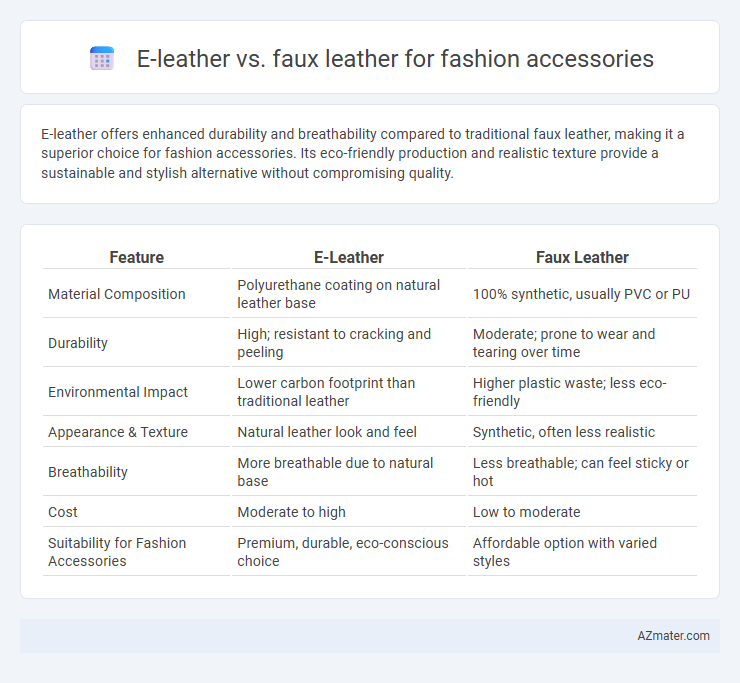E-leather offers enhanced durability and breathability compared to traditional faux leather, making it a superior choice for fashion accessories. Its eco-friendly production and realistic texture provide a sustainable and stylish alternative without compromising quality.
Table of Comparison
| Feature | E-Leather | Faux Leather |
|---|---|---|
| Material Composition | Polyurethane coating on natural leather base | 100% synthetic, usually PVC or PU |
| Durability | High; resistant to cracking and peeling | Moderate; prone to wear and tearing over time |
| Environmental Impact | Lower carbon footprint than traditional leather | Higher plastic waste; less eco-friendly |
| Appearance & Texture | Natural leather look and feel | Synthetic, often less realistic |
| Breathability | More breathable due to natural base | Less breathable; can feel sticky or hot |
| Cost | Moderate to high | Low to moderate |
| Suitability for Fashion Accessories | Premium, durable, eco-conscious choice | Affordable option with varied styles |
Introduction to E-Leather and Faux Leather
E-leather, also known as eco-leather, is a sustainable material made from a combination of natural fibers and polyurethane, designed to mimic the look and feel of genuine leather while offering enhanced durability and environmental benefits. Faux leather, typically crafted from polyvinyl chloride (PVC) or polyurethane (PU), is a synthetic alternative prized for its affordability and versatility in fashion accessories. Both materials provide cruelty-free options with varying degrees of breathability, texture, and lifespan, making them popular choices in eco-conscious and trend-driven markets.
Understanding the Manufacturing Processes
E-leather, derived from sustainable sources, involves a bio-based manufacturing process that integrates polyurethane with natural fibers, enhancing durability and eco-friendliness for fashion accessories. Faux leather is produced by coating a fabric base, often polyester or cotton, with a synthetic polymer like polyvinyl chloride (PVC) or polyurethane (PU), resulting in a versatile yet less sustainable material. Understanding these manufacturing processes highlights the environmental impact and performance differences crucial for selecting materials in fashion accessory design.
Key Material Differences
E-leather, made by combining natural leather with eco-friendly polymers, offers enhanced breathability and durability compared to traditional faux leather, which is primarily composed of synthetic materials like polyurethane or polyvinyl chloride (PVC). E-leather features a softer texture and better moisture management, making it more comfortable for fashion accessories such as bags and shoes. Faux leather, on the other hand, is less breathable and often less durable but is widely favored for its cost-effectiveness and versatility in design.
Sustainability and Environmental Impact
E-leather, made from plant-based or recycled materials, offers a more sustainable and eco-friendly option compared to traditional faux leather, which is typically crafted from PVC or polyurethane, contributing to plastic pollution and non-biodegradability. The production of E-leather generally has a lower carbon footprint and reduces reliance on fossil fuels, promoting circular economy principles in the fashion accessory industry. Consumers focusing on sustainability increasingly prefer E-leather for its reduced environmental impact, biodegradability, and ethical appeal in comparison to conventional synthetic alternatives.
Durability and Longevity Comparison
E-leather offers superior durability compared to traditional faux leather due to its advanced polyurethane coating and fabric backing, making it more resistant to wear and tear in fashion accessories. Faux leather, typically made from polyvinyl chloride (PVC), tends to crack and peel over time, reducing its longevity when exposed to frequent use or environmental stress. Choosing e-leather helps ensure extended product lifespan and sustained aesthetic appeal for accessories like handbags, belts, and wallets.
Aesthetic Qualities and Textures
E-leather for fashion accessories offers a premium texture with a natural grain pattern, closely resembling genuine leather's softness and flexibility. Faux leather tends to have a more uniform, synthetic surface that can appear less dynamic but is available in a wider range of finishes and colors for versatile design aesthetics. The tactile experience of e-leather is typically richer, providing a matte or semi-gloss finish that enhances sophisticated accessory styles.
Cost Efficiency and Market Prices
E-leather offers a cost-efficient alternative to traditional faux leather by utilizing innovative materials that reduce production expenses while maintaining durability, appealing to fashion accessory manufacturers aiming for budget-friendly options. Market prices for E-leather accessories typically range lower than high-quality faux leather products, enabling competitive retail pricing and higher profit margins for brands. The growing consumer demand for sustainable and affordable materials further drives the cost-effectiveness of E-leather in the fashion accessory market.
Maintenance and Care Requirements
E-leather offers superior durability and requires minimal maintenance compared to traditional faux leather, as its polyurethane coating resists cracking and peeling over time. Cleaning E-leather involves simple wiping with a damp cloth, while faux leather often demands special conditioners to prevent drying and flaking. Both materials benefit from avoiding prolonged exposure to direct sunlight and harsh chemicals to maintain their appearance and longevity.
Consumer Preferences and Trends
Consumers increasingly prefer E-leather over faux leather in fashion accessories due to its eco-friendly production methods and increased durability, appealing to sustainability-focused buyers. Market trends show a growing demand for ethically produced materials, with E-leather offering a biodegradable alternative while maintaining the aesthetic and texture of genuine leather. Fashion brands leverage these preferences by incorporating E-leather in wallets, bags, and shoes to attract environmentally conscious consumers seeking stylish yet responsible products.
Which is Better for Fashion Accessories?
E-leather, also known as bio-based or eco-friendly leather, offers superior durability, breathability, and a more authentic texture compared to traditional faux leather, making it a preferred choice for high-end fashion accessories. Faux leather is typically made from synthetic materials such as polyurethane or PVC, which can lack flexibility and may degrade faster under daily wear conditions. For fashion accessories, E-leather provides a sustainable, stylish, and long-lasting alternative, aligning with consumer demand for eco-conscious yet durable materials.

Infographic: E-leather vs Faux leather for Fashion accessory
 azmater.com
azmater.com